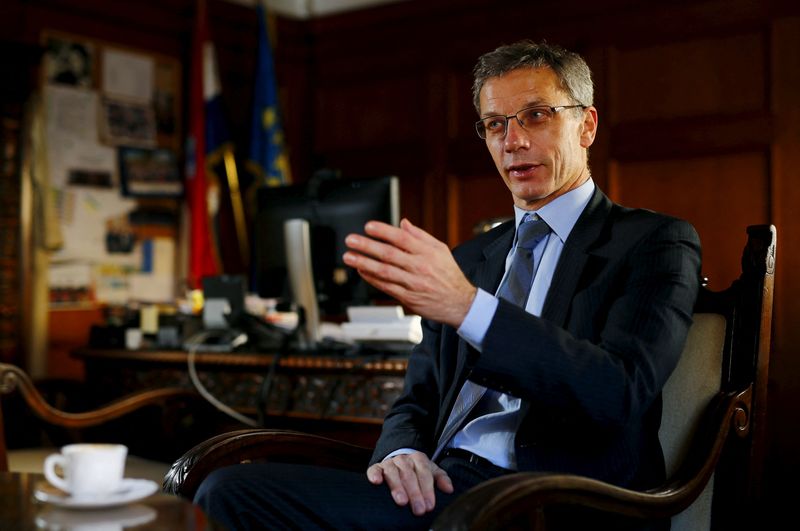ECB should not overreact to inflation edging below 2%, says Vujcic
The euro-zone economy remains at a delicate crossroads, with inflation hovering near target but not yet decisively anchored, and policy makers weighing the risks of both under- and over-tightening. In Dubrovnik, ECB policymaker Boris Vujcic urged caution against overreacting to inflation that has edged just below the 2% goal, arguing there are credible reasons to expect a rebound. He also highlighted the ECB’s ongoing balancing act as it prepares for a potential policy pause after a series of rate cuts, while the long-run strategy review continues to shape the central bank’s approach to quantitative easing and the role of asset purchases in reviving inflation when it remains too weak. The central bank’s latest move—an eighth rate reduction in a year followed by signals of a likely pause next month—frames a period of deliberate restraint amid uncertain global currents and evolving macro dynamics. The May flash reading showing euro-area inflation at 1.9% adds context to the debate about how stubborn or transitory price pressures will prove to be.
ECB policy stance and the case for measured flexibility
Boris Vujcic’s comments center on a fundamental principle: monetary policy should not chase every wobble around the target with aggressive responses. He explicitly rejected the notion of “precision surgery” on small deviations from the 2% goal, stressing that “a few tens of basis points’ deviation on either side of the target is not a problem.” He argued that such fluctuations will always occur, and treating them as systemic problems would risk overreacting and destabilizing the broader policy framework. This perspective sits at the heart of the ECB’s current approach: a willingness to tolerate minor, temporary misalignments in inflation as the economy cycles through energy-price movements, demand shifts, and global uncertainties, while preparing to act when there is a clearer and more persistent drift away from the target.
Vujcic also stressed that it is reasonable to anticipate that inflation will edge back up as energy prices find a bottom and the economy accelerates. This outlook aligns with the common European expectation that commodity price bottoms often precede a rebound in consumer price dynamics, particularly when domestic demand begins to firm and the labor market tightens. The notion that energy-price troughs can act as a temporary brake on inflation—before the pass-through from energy to broader price levels resumes—underpins the ECB’s cautious stance. In Vujcic’s view, the strength of the euro is unlikely to produce lasting second-round price effects unless the currency appreciates for an extended period across multiple quarters. That emphasis on the duration and persistence of currency moves acknowledges the risk that a stronger euro can initially dampen inflation by lowering import prices, but only if such strength endures long enough to influence wages, pricing behavior, and investment decisions.
The Croatian central bank governor also noted that some of the ECB’s colleagues worry about the risk that euro-area inflation could slow too much. In this sense, the policy debate within the ECB encompasses not just the speed of rate changes, but the broader concern about achieving a sustainable balance between price stability and macroeconomic recovery. The sense of risk in the inflation outlook, Vujcic suggested, is “pretty balanced,” yet there is acknowledged, “complete uncertainty” surrounding global trade tensions, particularly those involving the U.S. administration. This view points to a complex external environment in which the ECB’s policy path must be resilient to external shocks that could disrupt trade, investment, and global demand patterns.
The conversation around strategy and policy is inseparable from these questions. Vujcic’s remarks reflect a broader ECB sentiment that policy must remain adaptable, avoiding abrupt adjustments in response to modest fluctuations, while preserving the space to act decisively if inflation paths diverge meaningfully from expectations. The Bank’s emphasis on judgment and flexibility—rather than rigid, mechanical responses—serves as a core principle guiding the ongoing debate about how aggressively to respond to inflation that may wobble around the target before resuming a higher trajectory.
Inflation dynamics, energy prices, and the euro’s price-path implications
Inflation in the euro area stood at 1.9% in May on a flash estimate, underscoring the challenge of keeping price growth within the midterm target range. This backdrop informs the ECB’s tactical decisions: rate cuts have been deployed to support demand and economy-wide resilience, even as the central bank remains vigilant about price dynamics that are not yet decisively proving self-sustaining at the 2% level. The combination of a historically low inflation baseline and the potential for energy-price shifts to reassert influence means that the ECB must balance policy ease against the risk of embedding weaker inflation expectations.
Vujcic’s expectation that inflation will bounce back later rests on several plausible channels. First, energy prices often move in cyclical waves, and a bottoming process typically precedes a phase of price normalization across services and goods as demand conditions improve. Second, as the economy gains momentum—provided that investment remains resilient and consumer spending keeps contributing to growth—there is room for a pickup in domestically generated inflation pressures. This would manifest as stronger price growth in core components, even as headline inflation remains subject to energy-price swings and currency movements.
Euro strength’s impact on inflation hinges on the duration and persistence of the currency’s elevated level. If the euro remains strong for only a few quarters, price effects may be muted and transient. However, if the exchange rate sustains its strength over a longer horizon, import prices could continue to exert downward pressure on inflation in the short term, potentially delaying the return of inflation to the target. Conversely, a weaker euro could feed through to higher import prices and faster inflation, complicating the ECB’s balancing act. The interplay between currency movements and inflation expectations is a central theme in the policy discourse, as the ECB seeks to avoid a scenario where price expectations anchor too low or drift too high.
The possibility that euro-area inflation could slow too much remains a concern for some policymakers, notably including Portugal’s central bank governor Mario Centeno. The tension between preventing undershooting the target and ensuring a supportive policy stance for the real economy shapes the debate over the appropriate pace and timing of further steps in monetary accommodation. In Vujcic’s view, the inflation outlook remains “pretty balanced,” but he also acknowledges uncertainty—especially given the global trade tensions that complicate the trade and growth outlook. The net effect is a policy posture that aims to preserve optionality and cushion, while staying ready to adjust as the inflation path becomes clearer.
Investors and market participants watch for signals about whether the euro zone will experience a durable uplift in inflation or a protracted period of subdued price growth. The ECB’s strategy review, which examines the role of quantitative easing and other non-traditional measures, intersects with these inflation dynamics. If the central bank determines that QE has a meaningful, durable effect on inflation and long-term expectations, it could justify a more targeted approach to asset purchases in the future. If, however, QE is judged to have diminishing returns or to create distortions that risk future losses or bubbles, the strategy document may reflect a more cautious trajectory, with higher hurdles for future measures.
Energy price cycles and inflation also influence the real economy’s trajectory. If energy prices rise from a bottom and feed into consumer costs more broadly, the ECB could see renewed upward pressure on inflation with supportive implications for policy credibility. On the other hand, should energy prices remain subdued and the world economy lose momentum, the risk of inflation undershooting the target persists, reinforcing the case for measured, patient policy support. In either scenario, a careful calibration of near-term policy moves alongside long-horizon strategy considerations will be essential to preserving stability and confidence in the euro-area price level.
Quantitative easing and the long-term strategy: lessons, limits, and forward-looking questions
The ECB’s long-term strategy review is central to the policy conversation. It spans not only the immediate use of rates but also the broader question of how to deploy large-scale asset purchases—quantitative easing—and how those purchases interact with inflation dynamics, financial market stability, and the central bank’s balance sheet. The ECB has injected substantial liquidity into the banking system over the past decade through QE and related tools, with figures commonly described as totaling in the trillions of euros. This liquidity support has been credited with stabilizing markets during periods of stress, but it has also sparked ongoing debates about potential side effects, including asset-price distortions and the risk of bubbles in real estate and other sectors.
Vujcic drew attention to the possible need for higher scrutiny of QE going forward. He suggested that, while QE can help stabilize dysfunctional markets in crisis periods—such as those seen during the 2008 financial crisis and the COVID-19 pandemic—its marginal efficacy declines when used repeatedly over an extended horizon. The idea is that policies designed to shore up demand and inflation expectations may become less effective over time, especially if the objective becomes simply to lift inflation rather than to address deeper structural constraints in the economy. In this sense, the policy debate within the ECB’s hawkish wing and beyond emphasizes a need for structural reforms, credible fiscal support, and a careful balance between monetary stimulus and macroprudential considerations.
The central bank’s strategy review also contemplates the role of QE in reviving inflation when it is too low. The logic is straightforward: when inflation is persistently below target, asset purchases can lowers long-term interest rates, stimulate investment, and push up inflation expectations. However, the long-run risks are equally clear. Prolonged QE can distort asset markets, complicate the central bank’s exit path, and raise questions about the central bank’s accountability and the distributional effects of its policy choices. The ECB’s past reliance on QE, including the large scale of liquidity injections, has also drawn scrutiny from policymakers who worry about the potential for unintended consequences and about how to unwind the program without triggering volatility or market dysfunction.
In this light, the “bar” for future QE solutions is likely to be higher. The next time around, policymakers may insist on clearer triggers, stronger evidence of sustained inflation pressure, and better alignment with fiscal policy to ensure that the use of QE complements other measures rather than serving as a substitute for structural reforms or prudent macroprudential policies. Vujcic’s remarks emphasize that the central bank should learn from past episodes, applying lessons to calibrate any future use of asset purchases more precisely. This approach would seek to preserve policy space in the face of shocks while avoiding the kinds of distortions that have drawn criticism in the past.
The strategy debate also covers how the ECB should respond to calls for self-criticism within the broader policy community. There are voices within the ECB’s more hawkish camp that would push for a re-evaluation of the balance between quantitative easing and other tools, arguing for tighter monetary policy or a slower, more conditional path toward normalization if inflation indicators begin to firm. Reuters reporters have noted that while those calls for self-criticism are present, they are unlikely to feature prominently in the official strategy document, which is expected to be published in the upcoming summer. The tension between honest introspection and publishable policy messaging reflects the challenge of communicating a nuanced, forward-looking plan that can sustain credibility and minimize market disruption.
In practical terms, the ECB’s long-run strategy will need to reconcile a number of competing imperatives: the desire to support the real economy and avoid undershooting inflation, the risk of creating asset-price misalignments and the possibility of future losses on QE holdings, and the necessity to maintain a credible framework for price stability even as the global economy evolves. The policy debate is not purely theoretical; it has tangible implications for borrowers, savers, investors, and policymakers alike. The question for the ECB is whether QE, in its current form or in a reconfigured framework, can remain a useful instrument in the toolkit without generating excessive unintended consequences that could undermine financial stability or misallocate capital. As the strategy review unfolds, observers will be watching closely for signals about the thresholds, conditions, and time horizons that will govern the use of QE in the years ahead.
Global trade tensions, uncertainty, and the external environment
Beyond domestic considerations, the ECB’s outlook remains inseparable from the broader global context. Vujcic pointed to “complete uncertainty” surrounding global trade tensions, particularly those involving the U.S. administration. This uncertainty complicates the ECB’s efforts to forecast inflation, growth, and financial stability. Trade tensions can influence euro-area dynamics through several channels: they can affect export demand, disrupt supply chains, alter investment plans, and create volatility in exchange rates. All of these factors can translate into shifts in inflation dynamics and the relative attractiveness of monetary stimulus.
The external risk environment thus reinforces the case for prudence in policy conduct. While inflation has edged near the target and may rebound, the policy path must account for potential downside risks to growth and demand stemming from trade frictions and other geopolitical factors. In such conditions, the ECB’s decision to announce a probable pause after the next rate move reflects a cautious posture intended to preserve policy flexibility should new data point decisively toward higher or lower inflation pressure.
In the broader market context, the global monetary-policy landscape remains influenced by the inflation and growth trajectories of the major advanced economies. Central banks have demonstrated a preference for gradual normalization after extended periods of stimulus, but the exact sequencing and pace depend on domestic conditions and external shocks. For euro-area policymakers, the challenge is to provide a credible, data-driven path that manages expectations and reduces the risk of volatility around policy decisions. The balance between signaling and surprise—keeping markets aligned with the central bank’s intended trajectory—remains a central element of the communication strategy as the strategy review progresses.
The external environment also feeds into internal ECB dynamics, including debates about whether stronger global conditions could support a pickup in euro-area inflation, or whether headwinds abroad will weigh on domestic demand. The cross-border dimension of monetary policy means that the ECB’s decisions cannot be divorced from international developments. This interconnectedness underscores the importance of a robust framework for policy evaluation that integrates inflation expectations, financial stability considerations, and the potential spillovers of global activity into the euro area.
Historical perspective: Greenspan’s guidance and the inflation risk calculus
A distinctive thread in Vujcic’s discourse draws on historical insight from former U.S. Federal Reserve Chair Alan Greenspan, who advised that a high rate of inflation is more dangerous than a low one. Vujcic recalled Greenspan’s warning about the risks of deflationary periods when productivity growth reduced inflation. According to the retelling, Greenspan cited two decades of relatively benign deflation in the late 19th century, which the teacher of policy linked to productivity gains as an example of how markets can benefit from persistent productivity improvements that suppress inflation pressures. The implication of this historical reflection is not to romanticize deflation but to caution that policymakers must remain vigilant about raising inflation expectations to unnecessarily dangerous levels.
The quote, “Nobody cared about low inflation because of the productivity growth,” speaks to a counterintuitive dynamic in macro policy: even when inflation is low, the underlying productivity narrative can mask the need for policy coordination to ensure that inflation does not slip into a prolonged cycle of stagnation. The question arises: if inflation is too low for too long, does the economy risk losing its incentive to invest and innovate? Greenspan’s perspective underscores the tension between maintaining price stability and avoiding an overreaction to suppression of inflation that might otherwise be a symptom of healthier productivity and efficiency gains. Vujcic’s invocation of this history serves to anchor the current ECB debate within a broader framework of balancing inflation risks with the overall health of the macroeconomy.
The Greenspan anecdote is used to frame a policy stance that prioritizes the stabilization of inflation around a reasonable target while acknowledging that policy instruments must be exercised with a measured hand. The central lesson drawn is that monetary policy is not a tool for micromanaging short-term fluctuations, but rather a mechanism to maintain reliable price signals that support sustainable growth and employment. In the current euro-area context, this translates into a cautious approach to rate adjustments and a readiness to rely on a combination of instruments—together with structural reforms and prudent fiscal policy—to support a stable inflation path.
The hawkish vs. accommodative debate and the policy horizon
Within the ECB, there is a spectrum of views about how best to secure a stable inflation path without stifling growth. While Vujcic’s stance emphasizes dignity in tolerance for minor deviations and a cautious approach to policy shifts, there are voices within the euro-zone who worry that inflation could slow too much, potentially requiring continued monetary support. The tension is most visible in discussions about long-run strategy and the potential role of asset purchases in future stabilization efforts. The prospect of a more hawkish tilt—emphasizing earlier or more aggressive normalization—competes with the concerns voiced by those who fear undershooting the inflation target and jeopardizing a robust recovery.
The coming summer strategy document is expected to illuminate these tensions. Reuters sources have suggested that even as some policymakers press for more introspection regarding QE’s past effects and future appropriateness, these criticisms are unlikely to be front-and-center in the policy framework’s formal articulation. The policy document is expected to strike a balance: acknowledging the criticisms raised by hawkish factions, while preserving a consensus that prioritizes price stability, macroeconomic resilience, and credible communication with markets. The absence of a strong self-critique in the document would not erase the existence of the debate but would signal a preference for a unified external message as the ECB navigates a complex environment shaped by global trade tensions, energy price dynamics, and financial-market pressures.
Market implications and the policy communication challenge
From a market perspective, Vujcic’s framework provides a narrative for how to interpret the ECB’s signals. The emphasis on not overreacting to small deviations around the target can help explain why the central bank may maintain a steady course, tempering expectations of abrupt tightening or expansive QE beyond what is needed to sustain inflation momentum. For investors, this approach translates into a preference for patience and caution when it comes to pricing in future rate moves, particularly in a context where the energy cycle, currency movements, and external shocks could periodically swing inflation expectations.
The policy strategy’s communication is equally important. The ECB’s messaging must be precise enough to guide market expectations but flexible enough to accommodate evolving data. A key element of this communication challenge is the balance between signaling a pause and preserving the option to act quickly if inflation unexpectedly accelerates or the inflation path shifts toward the upper bound of the target. Conversely, if inflation remains stubbornly subdued for an extended period, the ECB will face pressure to explain why it did not provide more robust support to stimulate demand and fill gaps in the inflation process. The interplay between real economy outcomes and financial-market reactions will, in part, determine how effectively the ECB maintains credibility over the course of the strategy review process.
From the perspective of financial stability, QE’s future role will be closely watched. The historical experience of QE—its stability-providing role during crises, and the concerns about long-term distortions—will likely shape the design of any future program. Policymakers will seek to ensure that asset purchases do not inadvertently fuel asset bubbles or misallocate capital, while still offering a credible buffer against deflationary pressures and a credible anchor for inflation expectations. The ongoing assessment will weigh the benefits of liquidity injections against the potential costs to the long-run functioning of financial markets.
Conclusion
The ECB’s current posture, as articulated by Boris Vujcic in Dubrovnik, centers on measured, thoughtful policy: avoid overreacting to near-target inflation, acknowledge the likelihood of a later rebound as energy prices stabilize and the economy accelerates, and recognize that euro-strength is unlikely to trigger lasting price effects unless it persists for several quarters. While inflation’s path remains uncertain and global trade tensions cast a shadow over the outlook, the ECB is pursuing a strategy that blends rate adjustments with a careful appraisal of non-traditional tools such as quantitative easing, guided by a long-run strategy review that seeks to learn from past episodes and calibrate future actions accordingly.
The discussion around QE underscores a broader theme: the ECB must balance short-term stabilization with long-term prudence. The central bank’s past asset-purchase programs injected trillions of euros of liquidity, which helped stabilize markets during sharp episodes of stress but also raised concerns about the durability of their effects and the risk of bubbles. As the strategy document evolves, policymakers appear inclined to adopt a higher threshold for QE’s deployment in the future, while acknowledging that QE can play a stabilizing role in crises but that its marginal efficacy may decline if used for extended periods to achieve inflation objectives.
In this evolving setting, the ECB’s path will be shaped by a mix of domestic conditions, external shocks, and the ongoing debate among policymakers about how best to preserve price stability, support growth, and maintain financial-market integrity. The broader macroeconomic landscape—characterized by cyclical energy-price dynamics, currency movements, and trade tensions—will continue to influence the central bank’s decisions and the market’s expectations. As the strategy review is published and deliberations proceed, the ECB’s guiding principles—stability, credibility, and adaptability—will remain central to sustaining an environment conducive to durable inflation normalization and steady economic progress across the euro area.



